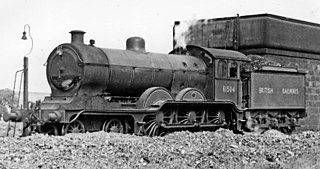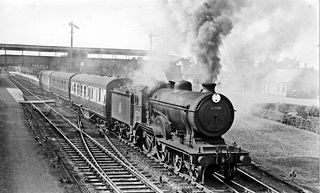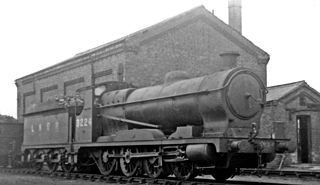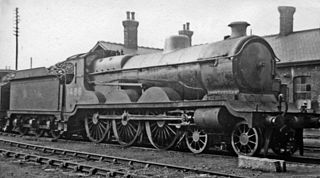| M&GN Class C LNER Classes D52, D53 & D54 | |||||||||||||||||||||||||||||||||||||||||||||
|---|---|---|---|---|---|---|---|---|---|---|---|---|---|---|---|---|---|---|---|---|---|---|---|---|---|---|---|---|---|---|---|---|---|---|---|---|---|---|---|---|---|---|---|---|---|
 M&GN class C 4-4-0, No. 076, at Peterborough North, 1938 | |||||||||||||||||||||||||||||||||||||||||||||
| |||||||||||||||||||||||||||||||||||||||||||||
| |||||||||||||||||||||||||||||||||||||||||||||
| |||||||||||||||||||||||||||||||||||||||||||||
| |||||||||||||||||||||||||||||||||||||||||||||
The M&GN Class C was a class of 4-4-0 steam tender locomotives of the Midland and Great Northern Joint Railway.
| M&GN Class C LNER Classes D52, D53 & D54 | |||||||||||||||||||||||||||||||||||||||||||||
|---|---|---|---|---|---|---|---|---|---|---|---|---|---|---|---|---|---|---|---|---|---|---|---|---|---|---|---|---|---|---|---|---|---|---|---|---|---|---|---|---|---|---|---|---|---|
 M&GN class C 4-4-0, No. 076, at Peterborough North, 1938 | |||||||||||||||||||||||||||||||||||||||||||||
| |||||||||||||||||||||||||||||||||||||||||||||
| |||||||||||||||||||||||||||||||||||||||||||||
| |||||||||||||||||||||||||||||||||||||||||||||
| |||||||||||||||||||||||||||||||||||||||||||||
The M&GN Class C was a class of 4-4-0 steam tender locomotives of the Midland and Great Northern Joint Railway.
The Midland and Great Northern Joint Railway (M&GN) was formed in 1893. The M&GN possessed insufficient locomotives to work all of its services, and so a number of locomotives were loaned by the railway's two co-owners, the Great Northern Railway and the Midland Railway (MR). To avoid the necessity for such loans, the MR's Locomotive Superintendent, Samuel Waite Johnson, designed a class of 4-4-0 tender locomotives specifically for use on the M&GN. These had much in common with the MR's 1808 class, [1] which had first appeared in 1888. [2] 26 locomotives of the new design were built by Sharp, Stewart & Co. in 1894, with a further seven following in 1896; a final seven were built by Beyer, Peacock & Co. in 1899 bringing the total to 40. [1] Their numbers on the M&GN were 1–7, 11–14, 17, 18, 36–39, 42–57, 74–80, and they formed M&GN Class C. [1] Ten more were built to the same design by Beyer, Peacock in 1900, but these were for the MR, where they formed the 2581 class. [3] [4]
As built, the engines had round-topped fireboxes, and the boiler barrel had a maximum diameter of 4 ft 3 in (1.30 m). When boilers became due for replacement, the replacement boilers were of various types, some of which had Belpaire fireboxes, and some were larger, being 4 ft 9 in (1.45 m) diameter. [5]
When they passed to the London and North Eastern Railway (LNER) on 1 October 1936, it was decided to add a zero prefix to their M&GN numbers, to avoid duplication with existing LNER engines, so M&GN no. 1 became LNER no. 01; [6] but 14 locomotives were withdrawn before the prefix could be applied. [7] The remaining 26 had their numbers altered between October 1936 and December 1937. [8]
On the LNER they initially retained the M&GN class C, but this was soon subdivided into C/1, C/2 and C/3 according to boiler design. They were reclassified as D52, D53 and D54 in July 1942: [3]
When the LNER post-war numbering scheme was prepared, it was based on the locomotive stock on 4 July 1943, [9] by which time 19 more had been withdrawn, leaving seven: [8] of these, class D52 nos. 038 & 076 were allotted 2050–1, class D53 nos. 050, 06 & 077 were to become 2052–4, and D54 nos. 055–6 were allotted 2055–6. [7] However, by the time that the scheme was issued in December that year, [9] a further four had been withdrawn, leaving just the three D53 in the final list; and before the renumbering actually began in January 1946, all three of those had also been withdrawn, the last in January 1945. [10]
None of the locomotives were preserved. However, a boiler does survive after being rediscovered in a Maldon timber works factory and there are talks of a static locomotive being built with the boiler. [11] [12]
John George Robinson CBE, was an English railway engineer, and was chief mechanical engineer of the Great Central Railway from 1900 to 1922.
The London and North Eastern Railway (LNER) produced several classes of locomotive, mostly to the designs of Nigel Gresley, characterised by a three-cylinder layout with a parallel boiler and round-topped firebox. It produced the most famous locomotive of its day, 4468 'Mallard', the holder of the world steam locomotive speed record. It also built the world-famous 4472 'Flying Scotsman'. However, its locomotive inheritance was much greater than just the 'A4 Class', it also produced highly successful mixed-traffic and freight designs.

The Great Eastern Railway (GER) Class S69, also known as 1500 Class, and later classified B12 by the London and North Eastern Railway (LNER) is a class of 4-6-0 steam locomotive designed to haul express passenger trains from London Liverpool Street station along the Great Eastern Main Line. Originally they were designed by S. D. Holden, but were much rebuilt, resulting in several subclasses.

The GER Class L77, LNER Class N7, is a class of 0-6-2T steam locomotives. They were designed by Alfred John Hill of the Great Eastern Railway and introduced in 1915. The design was perpetuated by Nigel Gresley of the LNER after the 1923 grouping. 134 were built and one example is preserved.

The Great Central Railway (GCR) Class 9F was a class of 0-6-2T steam locomotive built between 1891 and 1901. From 1923 the locomotives were redesignated Class N5.

The North Eastern Railway (NER) Class H, classified as Class Y7 by the London and North Eastern Railway (LNER) is a class of 0-4-0T steam locomotives designed for shunting.

The GER Classes S46, D56 and H88 were three classes of similar 4-4-0 steam locomotive designed by James Holden and A. J. Hill (H88) for the Great Eastern Railway.

The GER Class G58 was a class of 0-6-0 steam tender locomotives designed by James Holden for the Great Eastern Railway in England. The class consisted partly of new locomotives built from 1905 to 1911 and partly of rebuilds of the earlier GER Class F48 built from 1900 to 1903. The rebuilding started under GER auspices from 1921 and was continued by the London and North Eastern Railway (LNER) after grouping in 1923.

The first London and North Eastern Railway (LNER) Class A2 was a class of 4-6-2 steam locomotive designed by Vincent Raven for the North Eastern Railway. Two were built by the NER in 1922 before the grouping and another three by the LNER in 1924. Their LNER numbers were 2400–2404. All five locomotives were named by the LNER.
Thomas Wheatley (1821–1883) was an English mechanical engineer who worked for several British railway companies and rose to become a Locomotive Superintendent at the London and North Western Railway (LNWR) and the North British Railway (NBR).

The NER 901 Class was a class of 2-4-0 steam locomotive of the North Eastern Railway, designed by Edward Fletcher. Between 1872 and 1882 55 of the class were built for the NER.
The Midland Railway Johnson 0-6-0 were a class of locomotives serving Britain's Midland Railway system in the late 19th and early 20th centuries. Between 1875 and 1908 the Midland Railway, under the control of locomotive superintendents Samuel Waite Johnson and Richard Deeley, ordered 935 goods tender engines of 0-6-0 type, both from the railway's own shops at Derby and various external suppliers. Although there were many variations between different batches both as delivered and as successively rebuilt, all 935 can be regarded as a single series, one of the largest classes of engine on Britain's railways. The locomotives served as late as 1964, but none of them now survive.

The Great Central Railway (GCR) Class 8A was a class of 0-8-0 steam locomotive built between 1902 and 1911 for handling heavy coal trains over the Pennines. They all passed to the LNER in 1923, who redesignated them Class Q4. They were withdrawn from service between 1934 and 1951.
The NER 38 Class was a class of 4-4-0 steam locomotives designed by Alexander McDonnell for the North Eastern Railway. Twenty-eight were built in 1884–5, and remained in service until 1915–23.

The NBR 224 and 420 Classes consisted of six steam locomotives of the 4-4-0 wheel arrangement built by the North British Railway (NBR) in 1871 and 1873. No. 224 had three claims to fame: it was the first inside-cylinder 4-4-0 engine to run in Great Britain; it was the locomotive involved in the Tay Bridge disaster; and after rebuilding in 1885, it was the only compound-expansion locomotive on the NBR, and one of just three tandem compounds in Britain.
The Great Eastern Railway was formed on 1 August 1862, when the Eastern Counties Railway changed its name. The ECR had originally been built to 5 ft gauge, was converted to 4 ft 8+1⁄2 instandard gauge in September and October 1844.
GCR Class 8G was a class of 10 two-cylinder steam locomotives of the 4-6-0 wheel arrangement built in 1906 for the Great Central Railway.
The NBR 141 Class consisted of two steam 2-4-0 locomotives built by the North British Railway (NBR) in 1869. They were the direct antecedents of the NBR 224 Class 4-4-0.

The GCR Class 8F was a class of ten 4-6-0 locomotives built for the Great Central Railway in 1906 by Beyer, Peacock and Company to the design of John G. Robinson for working fast goods and fish trains. They passed to the London and North Eastern Railway at the 1923 grouping and received the classification 'B4'.
The NER Class V was a class of twenty steam locomotives of the 4-4-2 wheel arrangement. They were designed by Wilson Worsdell for the North Eastern Railway (NER) as express passenger locomotives.